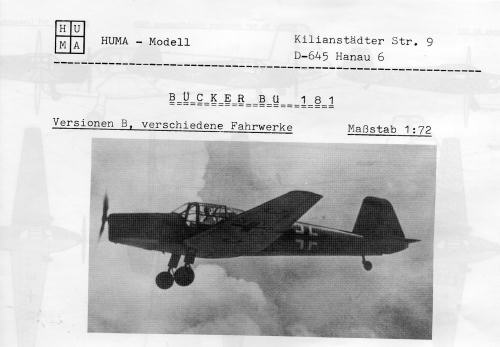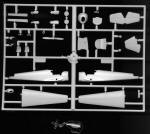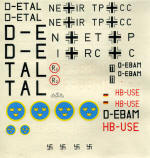
Huma 1/72 Bucker Bu-181
| KIT: | Huma 1/72 Bucker Bu-181 |
| KIT #: | ? |
| PRICE: | $9.98 when new |
| DECALS: | Seven options |
| REVIEWER: | Scott Van Aken |
| NOTES: | Short run injected kit |

| HISTORY |
The prototype Bü 181 (D-ERBV) made its maiden flight in February 1939 with Chief Pilot Arthur Benitz at the controls. After thorough works and official flight testing by the Reichsluftfahrtministerium (RLM) the Bü 181 was nominated to be the standard primary trainer for the Luftwaffe. Series production of the Bü 181 commenced in 1940/41. The types were designated A to D with only slight variations between each and could be powered either by the Hirth 500A or 504 engine.
The Bücker factory at Rangsdorf built most of the Bü 181's, but because of demand was forced to license the Fokker Company in the Netherlands, who subsequently built 373 of the type for the Luftwaffe all of which were delivered by the end of 1943.
Production of both the Bü 181A and the slightly modified Bü 181D was begun by Fokker in Amsterdam in 1942 and its total wartime production was 708 aircraft. Between 1943 and 1945, Hägglund & Söner AB in Sweden built 125 Bü 181's with the Hirth 500A engine with the Swedish military designation SK 25. Just prior to the German withdrawal from Czechoslovakia, production of the Bü 181D was initiated in the Zlin plant at Otrokovice, and production continued after the war, as the C.6 and C.106 for the Czechoslovak Air Force and as the Zlin Z.281 and Z.381 in various versions for civil use.
During the 1950s the Heliopolis Aircraft Works of Egypt acquired a Czechoslovak licence to produce the Bestmann in versions similar to the Zlin Z.381 with a 105 hp Walter-Minor engine. It was produced for the Egyptian Air Force as the Gomhouria ("Republic") and subsequent versions were supplied to other Arab air forces.
In all, 3,400 aircraft were built although only a handful survive today.
Although built as a primary trainer for the Luftwaffe, the type also performed other duties such as communication, glider towing, and even transporting Panzerfaust weapons (a rocket projectile with a hollow-charge warhead used as an infantry weapon against tanks.)
| THE KIT |
 Huma
started out producing a rather extensive batch of one-sprue kits that were short
run, but often superior to some of the 'mainstream' kits that one finds. These
all came in polybags with the cover of the instruction sheet as the 'box top'
and if the plane really existed, a photo was part of that.
Huma
started out producing a rather extensive batch of one-sprue kits that were short
run, but often superior to some of the 'mainstream' kits that one finds. These
all came in polybags with the cover of the instruction sheet as the 'box top'
and if the plane really existed, a photo was part of that.
The plastic on these kits is a somewhat soft white plastic. I found on this kit, for instance, that the detailing was well done with engraved panel lines (what few there are) and nicely done fabric representations. Only a tiny sink mark was found and there was a small amount of flash on some of the parts. All will need to be cleaned up anyway as the mold seams are more pronounced than you'll find on some other kits.
There really is only one option and that is on the landing gear legs where one option allows for the oleo and scissors to be covered. A single piece canopy is provided that is clear enough to see into the cockpit. Of this, there is not too much. Just seats, controls and instrument panel. But then one doesn't need all that much for a trainer. I should mention that though you are provided markings for a Panzerfaust equipped plane, these weapons are not included.
 The
instructions are superb as not only are there the usual construction drawings,
but you get full 1/72 three views of both the wheeled and ski-equipped planes.
Markings are provided for no fewer than 7 aircraft. One from pre-war, two RLM
70/71/65 painted planes from the basic training school in 1940 and the
aforementioned Panzerfaust unit in 1945. Two are Swedish builds, one for the
Swedish AF on skis and the other a civil marked plane in yellow. There is also a
French registered aircraft and a Swiss registered Zlin build. I'd give color
info, but the instructions use a greyshade equivalent chart that I can't really
decipher as the shades are so close. The large decal sheet is well printed and matte
with large carrier areas around the markings. Unusual for a German company, the
sheet includes swastikas, though they are not printed in the instructions as
such.
The
instructions are superb as not only are there the usual construction drawings,
but you get full 1/72 three views of both the wheeled and ski-equipped planes.
Markings are provided for no fewer than 7 aircraft. One from pre-war, two RLM
70/71/65 painted planes from the basic training school in 1940 and the
aforementioned Panzerfaust unit in 1945. Two are Swedish builds, one for the
Swedish AF on skis and the other a civil marked plane in yellow. There is also a
French registered aircraft and a Swiss registered Zlin build. I'd give color
info, but the instructions use a greyshade equivalent chart that I can't really
decipher as the shades are so close. The large decal sheet is well printed and matte
with large carrier areas around the markings. Unusual for a German company, the
sheet includes swastikas, though they are not printed in the instructions as
such.
| CONCLUSIONS |
None of their early kits are difficult builds, though one does have to take time to be sure of fit. Most of these are now in standard boxes and are not that difficult to locate. I'm not sure if Huma is still in business as they have not produced a new kit in several years.
| REFERENCES |
http://en.wikipedia.org
I bought this one and though you might like to see what it is like.
June 2008 If you would like your product reviewed fairly and quickly, please
contact
me or see other details in the
Note to
Contributors.